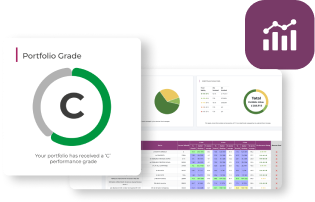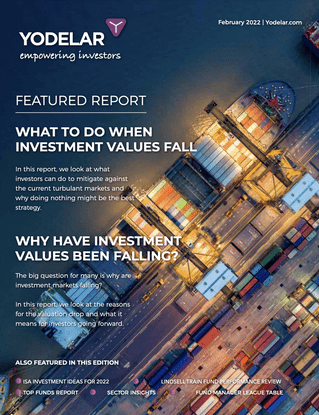-
Many investor portfolios that appear well structured contain hidden inefficiencies such as duplication, allocation drift, and underperforming funds that can quietly affect long-term results.
-
The Yodelar Portfolio Analysis provides an independent, data-driven review of your portfolio, benchmarking each fund against its sector average over 1, 3, and 5 years.
-
It assesses diversification across regions, sectors, and asset classes, identifying overlapping holdings or areas of overexposure that may increase risk.
-
The analysis measures whether your portfolio’s current structure remains aligned to your intended level of risk and investment objectives.
-
Investors receive a clear report highlighting where portfolios are performing well, where improvements could be made, and how overall efficiency can be enhanced — all without providing personalised advice or product recommendations.
On the surface, many investors feel confident about their portfolios. The funds are familiar, the charts appear steady, and diversification looks adequate. Yet beneath this reassuring picture, portfolios that appear balanced can conceal inefficiencies that quietly affect long-term performance and risk exposure.
At Yodelar, our analysts review thousands of investor portfolios each year. Many contain overlapping holdings, outdated fund selections, or imbalanced allocations that have drifted over time. These issues are not obvious from a statement or platform dashboard but can still have a material effect on returns and risk control.
This article outlines several of the most common portfolio pitfalls, explains why they occur, and highlights how regular analysis can help identify and correct them. It is intended for educational purposes only and does not constitute investment advice.
The Portfolio Pitfalls Investors Can Miss
Our short video, The Portfolio Pitfalls Investors Can Miss, explores these themes further — from overlapping holdings and allocation drift to the gradual changes in fund behaviour that can go unnoticed.
When a Healthy-Looking Portfolio Isn’t as Strong as It Seems
Diversification is often viewed as a simple exercise — owning a range of funds across different providers. However, true diversification is about ensuring that each investment behaves differently in changing market conditions.
One of the most frequent inefficiencies we encounter is duplication of underlying holdings. For example, a portfolio may include several global or UK equity funds that each hold similar large companies such as Microsoft, Apple, or Shell. This overlap creates the appearance of diversification while actually concentrating exposure in a small number of shares.
When those companies experience volatility, multiple funds in the portfolio can be affected at the same time. The intended risk spread is therefore reduced, and the portfolio can behave less predictably than expected.
The Diversification Myth: When More Funds Don’t Mean Less Risk
Owning many funds does not automatically mean owning many opportunities. What matters is correlation — how different investments move relative to one another.
Our portfolio reviews frequently show that investors who hold 15 or more funds may, after accounting for overlap, have exposure to fewer than 60 distinct companies worldwide. This can significantly reduce the benefits of diversification and increase dependence on a narrow part of the market.
A robust portfolio aims to combine assets, sectors, and regions that do not all rise or fall together. Without detailed analysis of underlying holdings, investors can easily mistake quantity for quality.
How Portfolio Drift Quietly Changes Your Level of Risk
Another hidden problem is allocation drift. Over time, as markets move, the proportion of equities, bonds, and other assets within a portfolio can change without deliberate action.
For instance, if shares perform strongly, they may grow to dominate the portfolio, increasing overall risk exposure. Conversely, defensive assets such as bonds may shrink in weight, reducing the intended stability.
A portfolio that began with a balanced 60/40 mix could, after several years of market movement, become heavily skewed toward equities. Without regular rebalancing, the portfolio may take on more risk than the investor originally intended — or miss opportunities in areas that have fallen out of favour.
When Star Funds Lose Their Spark
Fund performance is cyclical. A manager who once delivered strong returns may find conditions less favourable in future periods. Some funds evolve in ways that investors are not aware of, whether through changes in size, management style, or investment strategy.
Our research across the Investment Association sectors shows that a significant proportion of large and popular funds have delivered returns below their respective sector averages over the past five years. This does not make them unsuitable, but it does illustrate how performance leadership changes over time.
Past performance should never be relied upon as an indicator of future results, and even established funds require ongoing evaluation to ensure they remain appropriate for a portfolio’s objectives and risk profile.
The Compounding Cost of Inefficiency
Charges are another important component of portfolio outcomes. Each layer of cost — fund management, platform, and adviser fees — compounds over time. Even small percentage differences can add up to a meaningful impact on long-term growth.
When analysing portfolios, we often identify opportunities to improve efficiency by removing duplication or selecting cost-effective alternatives that meet the same objectives. However, cost should always be assessed alongside suitability and diversification — cheaper does not automatically mean better.
Understanding total ongoing charges and ensuring they align with the value delivered is a key step in maintaining portfolio discipline.
Why DIY Investors Often Miss These Warning Signs
Building a portfolio is one challenge; maintaining it effectively is another. Without structured oversight, even the best portfolios can drift or become concentrated.
As the second video on this page, Building the Right Portfolio, highlights:
“Owning 20 funds isn’t true diversification if they all invest in the same type of companies. The world changes, markets change, and your portfolio needs to adapt.”
Investors managing their own portfolios may find it difficult to monitor performance across multiple funds, assess overlap, and evaluate risk in the context of changing market conditions. Professional oversight can help ensure portfolios remain balanced, appropriately diversified, and aligned to an investor’s long-term goals.
Building the Right Portfolio
This video explores the principles of sound portfolio construction — the blend of assets, cost awareness, and the importance of ongoing maintenance — all central to sustaining efficiency over time.
How a Yodelar Portfolio Analysis Helps Identify Inefficiencies
Yodelar’s Free Portfolio Analysis is designed to help investors understand how efficiently their portfolio is structured. It provides a factual, independent breakdown showing:
-
How each fund has performed relative to its sector average over one, three, and five years.
-
Whether diversification is genuine or affected by duplication of underlying holdings.
-
How the portfolio’s risk exposure compares with the investor’s stated risk tolerance.
-
The total ongoing charges for the funds held, and whether cost savings may be possible.
The analysis is purely informational and does not make personalised investment recommendations. It enables investors to make more informed decisions and, if desired, to discuss the findings with a regulated financial adviser.
Why Regular Oversight Keeps Portfolios on Track
Financial markets are dynamic. Economic cycles, sector trends, and manager decisions all influence performance. Regular analysis helps ensure portfolios continue to reflect their intended objectives and risk parameters.
For investors who prefer professional management, discretionary services such as those available through regulated firms can provide ongoing monitoring and timely adjustments. This proactive approach can help maintain diversification and manage risk more effectively as conditions evolve.
However, it is important to remember that all investments involve risk, and the value of your investments can go down as well as up. You may not get back the amount you originally invested.
See What Your Portfolio Could Really Achieve
If you have not reviewed your portfolio in the past year, a structured analysis can provide clarity on how efficiently your investments are working.
Yodelar’s Free Portfolio Analysis includes a detailed report and optional discussion with one of our portfolio specialists. Together, these will help you understand your portfolio’s strengths, identify potential areas for improvement, and ensure your investment strategy remains aligned with your objectives.
Even if you have completed a review before, market conditions change — and portfolios should evolve with them.
Book your free analysis today to see what’s really going on beneath the surface of your portfolio.
















